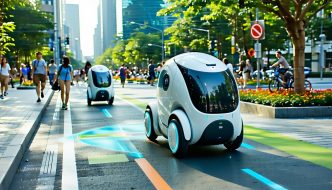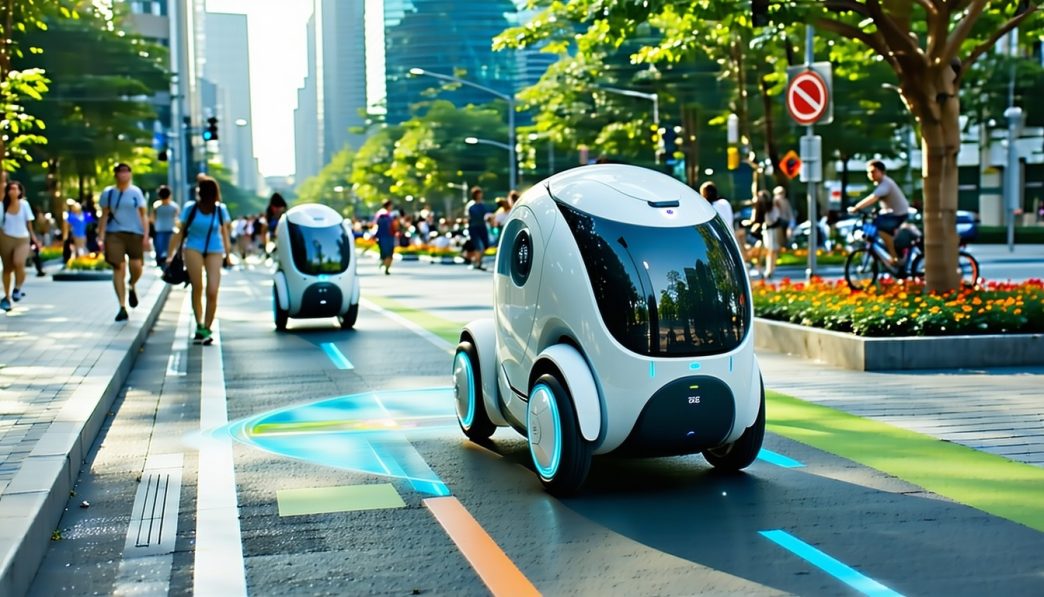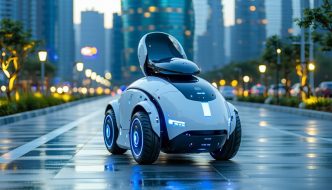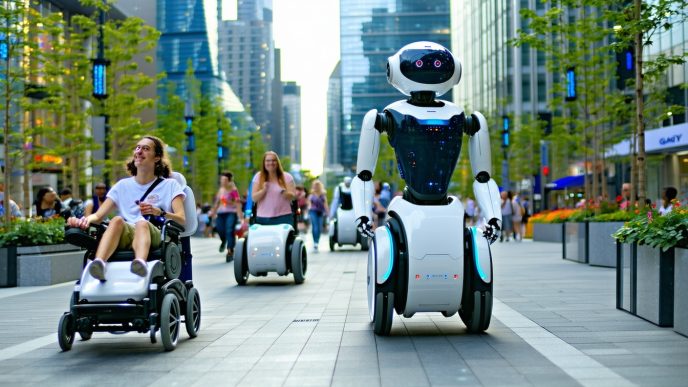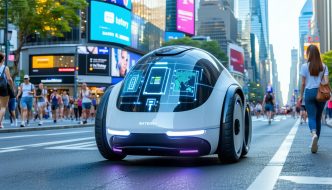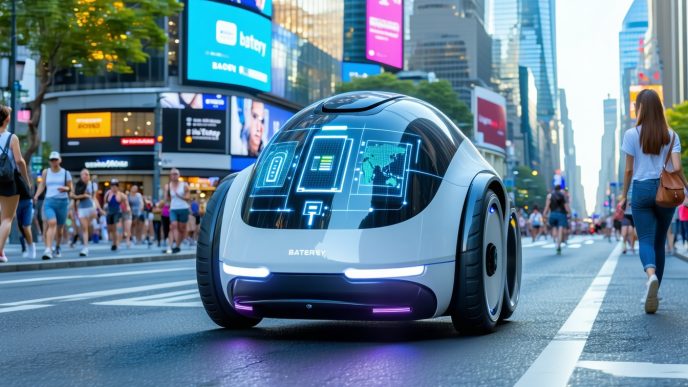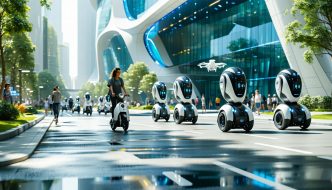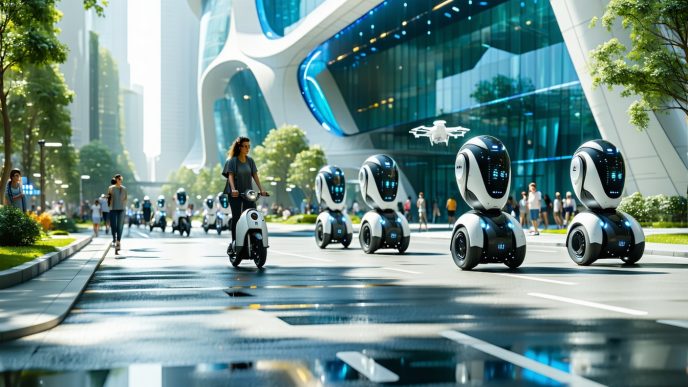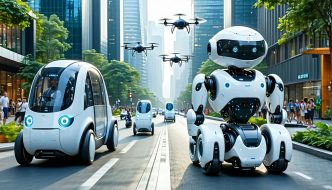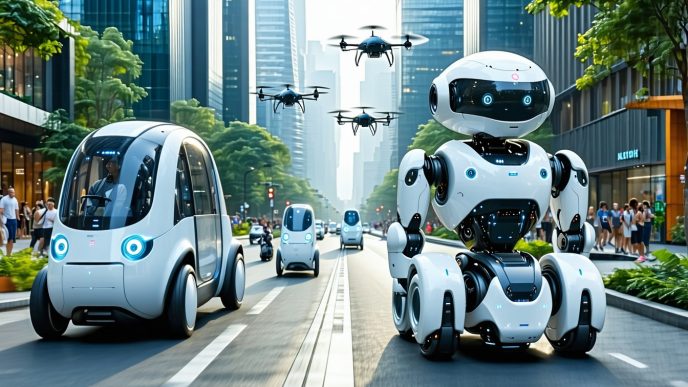Rise of Rideable Robots
The transportation landscape has transformed significantly over the past few decades, evolving from conventional methods to innovative alternatives. As urbanization continues to rise, the demand for efficient and convenient modes of travel has led to the emergence of rideable robots.
Evolution of Transportation Solutions
Historically, transportation solutions have evolved through various phases, including the advent of bicycles, motorized vehicles, and public transit systems. Over time, the increasing population density in urban areas has highlighted the necessity for alternatives that alleviate congestion and reduce travel times.
In response to these needs, rideable robots have emerged as a modern solution. These devices provide a seamless means of navigation for short trips, catering to urban commuters who are looking for quick, efficient ways to travel within cities.
The table below illustrates the evolution of personal transportation over the years, showcasing the rise of rideable robots alongside previous innovations.
| Year | Transportation Solution |
|---|---|
| 1820s | Bicycle |
| 1900s | Motor Vehicle |
| 1960s | Public Transit Systems |
| 2000s | E-Scooters and E-Bikes |
| 2020s | Rideable Robots |
Rideable robots are increasingly becoming a part of the urban mobility ecosystem as individuals seek environmentally friendly and hassle-free commuting options.
Introduction to Rideable Robots
Rideable robots are advanced personal transport devices designed for individual use, equipped with technology that enhances maneuverability and ease of use. They are typically battery-operated and offer a range of features that cater specifically to urban mobility challenges.
These robots include various forms of transportation, such as electric unicycles, self-balancing scooters, and electric skateboards. Each type is designed to facilitate short trips in urban environments, providing an alternative to traditional transportation methods.
The benefits of rideable robots are evident, as they offer a compact, convenient, and often eco-friendly way to traverse busy city streets. With features like smart connectivity and enhanced rider interfaces, these devices appeal to tech enthusiasts and mobility innovators alike. For further exploration of the advantages and applications of these technologies, refer to our article on transportation and rideability robots.
Rideable robots represent an ongoing evolution in personal mobility, addressing the need for efficient, flexible, and sustainable transport solutions in an ever-changing urban landscape.
Benefits and Applications
Rideable robots are transforming transportation methods, particularly for short trips within urban environments. Their unique applications provide numerous advantages for commuters, including efficiency, enhanced connectivity, and eco-friendliness.
Efficiency in Urban Commuting
Rideable robots significantly improve commuting efficiency. With the ability to navigate through traffic and streamline travel routes, these devices reduce travel time for users. They provide an innovative solution for urban areas where congestion is prevalent.
Efficiency Metrics for Rideable Robots
| Feature | Traditional Transport | Rideable Robots |
|---|---|---|
| Average Speed (mph) | 15 – 25 | 10 – 20 |
| Estimated Travel Time (1 Mile) | 5 – 10 mins | 3 – 5 mins |
| Energy Consumption (per mile) | 0.5 – 2 kWh | 0.1 – 0.3 kWh |
Using rideable robots allows for swift transitions from home to work, enabling more productive time management for commuters. This enhancement in efficiency is essential in the fast-paced urban lifestyle.
Last-Mile Connectivity Solutions
For commuting scenarios, the last mile remains a challenge. Rideable robots offer effective solutions by bridging distances between public transportation hubs and final destinations. This reduces the need for personal vehicles while improving access to public transit systems.
| Transportation Method | Range (Miles) | Average Travel Time (mins) |
|---|---|---|
| Walking | 0.5 – 1 | 10 – 20 |
| Public Transit | 1 – 5 | 15 – 30 |
| Rideable Robots | 0.5 – 3 | 5 – 15 |
Users can seamlessly integrate rideable robots into their daily routines, enhancing mobility for those who rely on public transport.
Eco-Friendly Alternative
Another significant benefit of rideable robots lies in their environmental friendliness. Many models operate with electric motors, resulting in lower emissions compared to traditional gasoline-powered vehicles. As cities focus on sustainability, adopting rideable robots contributes to reducing urban pollution.
Environmental Impact Statistics
| Metric | Traditional Vehicles | Rideable Robots |
|---|---|---|
| CO2 Emissions (per mile) | 0.8 – 1.2 kg | 0 – 0.1 kg |
| Noise Pollution Level (dB) | 70 – 90 | 30 – 50 |
| Energy Source | Fossil Fuels | Electric |
With the shift towards cleaner transportation solutions, embracing rideable robots can provide an eco-friendly alternative that aligns with sustainability goals. As the demand for greener commuting options grows, rideable robots are positioned to play a pivotal role in the future of urban mobility.
For more insights on the integration of robot technology in transportation, refer to our article on robot transportation vs traditional options.
Types of Rideable Robots
Rideable robots are becoming increasingly popular for their efficiency and mobility. Various types cater to different needs and preferences of urban commuters and tech enthusiasts. This section will discuss three prominent categories: electric unicycles, self-balancing scooters, and electric skateboards.
Electric Unicycles
Electric unicycles represent a unique take on personal mobility. They consist of a single wheel and are controlled by the rider’s body movements. To move forward, the rider leans slightly forward, while leaning back allows for braking.
Electric unicycles often feature lightweight designs, making them easy to carry. They are an ideal choice for those looking for compact and portable options. Below is a quick comparison of features:
| Feature | Average Specification |
|---|---|
| Weight | 20-30 lbs |
| Speed | 15-25 mph |
| Range | 15-50 miles |
| Battery Charge Time | 1-6 hours |
For further details on battery performance, review our article on battery range for rideable robots.
Self-Balancing Scooters
Self-balancing scooters, commonly known as hoverboards, have gained popularity among riders of all ages. These devices feature two parallel wheels and utilize gyroscopic sensors to maintain balance. Riders control their speed and direction by shifting their weight.
Self-balancing scooters are versatile and can be used for short trips, making them suitable for urban commuting. Key specifications include:
| Feature | Average Specification |
|---|---|
| Weight | 20-30 lbs |
| Speed | 6-12 mph |
| Range | 6-20 miles |
| Battery Charge Time | 2-4 hours |
For more insights on stability and safety concerns, check our article on rideable robot stability and safety.
Electric Skateboards
Electric skateboards combine traditional skateboarding elements with modern technology. They come equipped with electric motors and allow riders to control speed using a handheld remote. This type of rideable robot is perfect for those who enjoy skateboarding but want added convenience.
Electric skateboards are popular for commuting over varied terrains. Here are some typical features:
| Feature | Average Specification |
|---|---|
| Weight | 15-25 lbs |
| Speed | 12-30 mph |
| Range | 10-30 miles |
| Battery Charge Time | 1-3 hours |
For a comparative view of rideable robots versus traditional options, see our article on robot transportation vs traditional options.
Each type of rideable robot offers unique benefits for short trips and urban commuting, making them appealing alternatives for mobility enthusiasts.
Technology Behind Rideable Robots
The technology behind rideable robots plays a crucial role in enhancing personal mobility, especially for urban commuters. By integrating advanced components such as electric motors, control systems, and smart connectivity features, these devices have become an innovative solution for short trips.
Electric Motors and Batteries
Electric motors are at the heart of rideable robots, providing the necessary propulsion for efficient travel. These motors convert electrical energy from batteries into mechanical energy, powering the movement of the device. The effectiveness of the rideable robot largely depends on the type and capacity of the battery it uses.
A comparison of common electric motor and battery specifications for rideable robots is provided in the table below:
| Component | Specification |
|---|---|
| Motor Type | Brushless DC Motors |
| Typical Power Output | 250 – 800 Watts |
| Battery Type | Lithium-Ion |
| Average Battery Capacity | 200 – 500 Wh |
| Average Range | 20 – 40 miles |
| Charging Time | 2 – 6 hours |
For more insights on battery efficiency, visit our article on battery range for rideable robots.
Control Systems and Sensors
Control systems are integral to the operation of rideable robots, ensuring stability and responsiveness. These systems utilize various sensors to gather data about the robot’s environment and user input, facilitating safe and smooth rides. Gyroscopic sensors often help maintain balance, while accelerometers monitor speed and tilt angles.
Common control system features include:
- Speed Regulation: Automatically adjusts power based on the rider’s speed.
- Obstacle Detection: Utilizes proximity sensors to identify and navigate around obstacles.
- User Interface: Displays battery life, speed, and other essential information.
For more details on user interfaces, check our article on robot rider interfaces.
Connectivity and Smart Features
Modern rideable robots are equipped with connectivity features that enhance user experience. Many devices can connect to mobile applications via Bluetooth or Wi-Fi, allowing users to customize settings and receive real-time updates. Smart features may include GPS navigation, trip tracking, and integration with other transportation services.
Some notable connectivity features include:
- App Integration: Allows users to monitor battery health and usage statistics.
- Remote Locking: Provides security by allowing users to lock the device remotely.
- Navigation Assistance: Offers route optimization and traffic updates.
The integration of smart technology paves the way for improved personal mobility solutions. As the technology progresses, it’s expected that rideable robots will continue to evolve, enhancing their role in urban commuting. For a look ahead at emerging trends, visit our article on the future of rideable robotics.
Challenges and Considerations
As rideable robots gain popularity for short trips, several challenges and considerations must be addressed to ensure their successful integration into urban mobility solutions.
Safety Concerns
Safety is a primary concern when it comes to rideable robots. Potential risks include accidents involving pedestrians, cyclists, and vehicle interactions. Users need to be educated about proper riding techniques and safety practices.
| Safety Feature | Description |
|---|---|
| Stability Control | Helps maintain balance during use |
| Speed Limiters | Restricts maximum speed to promote safety |
| Alert Systems | Provides warnings for potential hazards |
Devices equipped with enhanced stability and alert systems can mitigate accident risks. Comprehensive guidelines for safe riding are essential for reducing injuries in urban environments. For further details on safety features, see our article on rideable robot stability and safety.
Legal Regulations
Legal frameworks play a significant role in the deployment of rideable robots. Different regions may have varying regulations regarding where and how these devices can operate. Compliance with local laws is crucial to avoid fines and other penalties.
| Regulation Type | Examples |
|---|---|
| Speed Restrictions | Limits on maximum allowable speed |
| Operating Zones | Designated areas for use |
| Registration Requirements | Licensing and insurance mandates |
Understanding these regulations can help users and developers navigate the evolving landscape of rideable robotics. To explore more about the contrast between robot transportation and traditional options, read our article on robot transportation vs traditional options.
Maintenance and Durability
Maintenance is an important aspect of using rideable robots. Regular servicing ensures that these devices remain functional and safe over time. Factors such as battery life, wear on components, and general upkeep contribute to overall durability.
| Maintenance Task | Frequency |
|---|---|
| Battery checks | Monthly |
| Tire inspections | Monthly |
| General cleaning | As needed |
Ensuring that users understand maintenance schedules and procedures is critical for the longevity of rideable robots. Details about battery specifications can be found in our article on battery range for rideable robots.
By addressing these challenges, the integration of rideable robots into everyday use can be smoother and more effective, paving the way for innovative transportation solutions in urban settings.
The Future of Personal Mobility
As urban landscapes evolve, the future of personal mobility increasingly revolves around the integration of rideable robots into existing transportation networks. This shift not only enhances convenience for users but also offers innovative solutions to longstanding urban mobility challenges.
Integration with Public Transportation
The future of rideable robots for short trips lies in their seamless integration with public transportation systems. This can create a more cohesive travel experience for commuters. By connecting bike-sharing, bus routes, and train stations with last-mile solutions, rideable robots can fill gaps in transportation networks, significantly improving accessibility.
Potential partnerships between public transit authorities and rideable robot service providers can help streamline the transition. Users would be able to access rideable robots just steps away from metro stations or bus stops, making their journeys more efficient. Data from urban mobility studies indicate that integration can reduce overall commuting time by up to 30%.
| Integration Benefit | Potential Impact |
|---|---|
| Reduced Travel Time | 30% decrease in commuting duration |
| Increased Accessibility | Wider reach for underserved areas |
| Enhanced Convenience | Simplified transfers between modes |
Impact on Urban Infrastructure
The rise of rideable robots will also affect urban infrastructure planning. Cities may need to adapt existing pathways, sidewalks, and roadways to accommodate these new forms of transportation safely. Designated lanes for rideable robots can ensure smoother traffic flow and reduce conflicts with pedestrians.
Moreover, the adoption of rideable robots could encourage the creation of smart city initiatives focused on mobility. Incorporating Wi-Fi and IoT technology can lead to better monitoring and management of transport systems. Urban planners may work towards creating infrastructure that supports multimodal transport, further facilitating the transition to automated options.
| Infrastructure Changes | Expected Outcomes |
|---|---|
| Smart sidewalks for rideable robots | Improved safety and efficiency |
| Expanded docking stations near transit hubs | Higher convenience for users |
| Better traffic management systems | Reduced congestion in urban areas |
Innovations and Future Trends
The next phase in rideable robots is defined by ongoing innovations in technology. Future models are likely to incorporate advanced features like AI for improved navigation and decision-making. Enhanced battery technology will enable longer ranges, as covered in our article on battery range for rideable robots, allowing for extended use without frequent recharging.
Improvements in user interfaces, as described in our article on robot rider interfaces, are also expected. Future generation rideable robots may come equipped with voice recognition and app connectivity, offering users real-time route planning and traffic updates.
Moreover, the potential development of autonomous rideable robots indicates a paradigm shift in personal mobility. They could eventually operate independently, transporting users without the need for manual operation. For insights into how these innovations measure against traditional options, see our comparison on robot transportation vs traditional options.
The future ahead is filled with possibilities for rideable robots, paving the way for efficient, enjoyable, and eco-friendly urban commutes.

